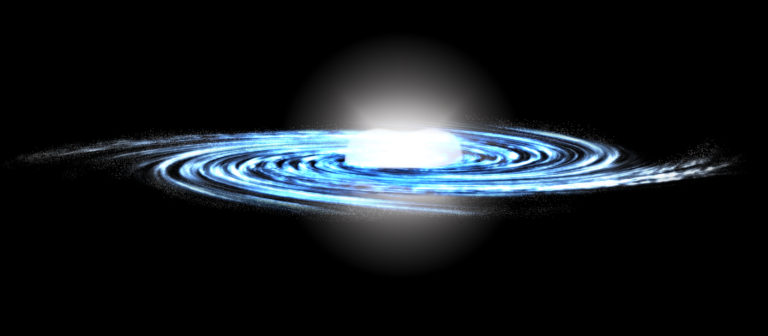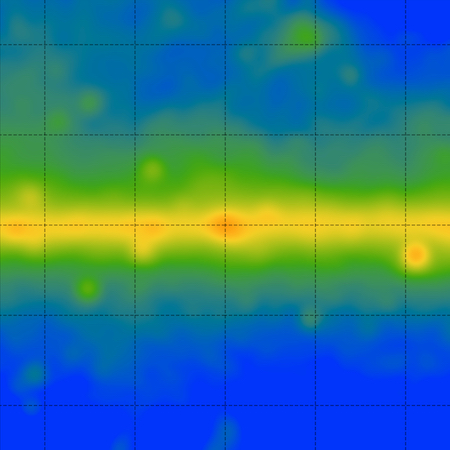September 14, 2020
Kavli Institute for the Physics and Mathematics of the Universe (Kavli IPMU)
The detection more than a decade ago by the Fermi Gamma-ray Space Telescope of an excess of high-energy radiation in the center of the Milky Way convinced some physicists that they were seeing evidence of the annihilation of dark matter particles, but a team led by a researcher at the Kavli Institute for the Physics and Mathematics of the Universe (Kavli IPMU) has ruled out that interpretation.
In a paper published recently in the journal Physical Review D, the Kavli IPMU Project Researcher Oscar Macias and colleagues at other institutions report that—through an analysis of the Fermi data and an exhaustive series of modelling exercises—they were able to determine that the observed gamma rays could not have been produced by what are called weakly interacting massive particles (WIMPS), most popularly theorized as the stuff of dark matter.
“The crucial point of our recent paper is that, our approach covers the wide range of astro-physical background models that have been used to infer the existence of the Galactic Center excess, and goes beyond them. So, using any of our state-of-the-art background models, we find no need for a dark matter component to be included in our model for this sky region. This allows us to impose very stringent constraints on particle dark matter models,” said Macias.
By eliminating these particles, the destruction of which could generate energies of up to 300 giga-electron volts, the paper’s authors say, they have put the strongest constraints yet on dark matter properties.
“For 40 years or so, the leading candidate for dark matter among particle physicists was a thermal, weakly interacting and weak-scale particle, and this result for the first time rules out that candidate up to very high-mass particles,” said co-author Kevork Abazajian, pro-fessor of physics and astronomy at the University of California, Irvine (UCI).
“In many models, this particle ranges from 10 to 1,000 times the mass of a proton, with more massive particles being less attractive theoretically as a dark matter particle,” add-ed co-author Manoj Kaplinghat, also a UCI professor of physics and astronomy. “In this paper, we’re eliminating dark matter candidates over the favored range, which is a huge improvement in the constraints we put on the possibilities that these are representative of dark matter.”
Abazajian said that dark matter signals could be crowded out by other astrophysical phenomena in the Galactic Center—such as star formation, cosmic ray deflection off mo-lecular gas and, most notably, neutron stars and millisecond pulsars—as sources of ex-cess gamma rays detected by the Fermi space telescope.
“We looked at all of the different modelling that goes on in the Galactic Center, including molecular gas, stellar emissions and high-energy electrons that scatter low-energy pho-tons,” said Kavli IPMU’s Macias. “We took over three years to pull all of these new, better models together and examine the emissions, finding that there is little room left for dark matter.”
Macias, who is also a postdoctoral researcher with the GRAPPA Centre at the University of Amsterdam, added that this result would not have been possible without data and software provided by the Fermi Large Area Telescope collaboration.
The group tested all classes of models used in the Galactic Center region for excess emission analyses, and its conclusions remained unchanged. “One would have to craft a diffuse emission model that leaves a big ‘hole’ in them to relax our constraints, and sci-ence doesn’t work that way,” Macias said.
Kaplinghat noted that physicists have predicted that radiation from dark matter annihila-tion would be represented in a neat spherical or elliptical shape emanating from the Ga-lactic Center, but the gamma ray excess detected by the Fermi space telescope after its June 2008 deployment shows up as a triaxial, bar-like structure.
“If you peer at the Galactic Center, you see that the stars are distributed in a boxy way,” he said. “There’s a disk of stars, and right in the center, there’s a bulge that’s about 10 degrees on the sky, and it’s actually a very specific shape—sort of an asymmetric box—and this shape leaves very little room for additional dark matter.”
Does this research rule out the existence of dark matter in the galaxy? “No,” Kaplinghat said. “Our study constrains the kind of particle that dark matter could be. The multiple lines of evidence for dark matter in the galaxy are robust and unaffected by our work.”
Far from considering the team’s findings to be discouraging, Abazajian said they should encourage physicists to focus on concepts other than the most popular ones.
“There are a lot of alternative dark matter candidates out there,” he said. “The search is going to be more like a fishing expedition where you don’t already know where the fish are.”
This project was made possible via funding from the World Premiere International Center Initiative (WPI), an initiative of the Ministry of Education, Culture, Sport, Science and Technology to create world-leading research centres in Japan; the National Science Foundation, and the U.S. Department of Energy Office of Science.
Paper details
Journal: Physical Review D
Title: Strong constraints on thermal relic dark matter from Fermi-LAT observations of the Galactic Center
Authors: Kevork N. Abazajian (1), Shunsaku Horiuchi (2), Manoj Kaplinghat (1), Ryan E. Keeley (1,3), and Oscar Macias (4,5)
Author affiliations:
1. Center for Cosmology, Department of Physics and Astronomy, University of California, Irvine, California 92697, USA
2. Center for Neutrino Physics, Department of Physics, Virginia Tech, Blacksburg, Virgin-ia 24061, USA
3. Korea Astronomy and Space Science Institute, Daejeon 34055, Korea
4. Kavli Institute for the Physics and Mathematics of the Universe (Kavli IPMU, WPI), Uni-versity of Tokyo, Kashiwa, Chiba, 277-8583, Japan
5. GRAPPA Institute, University of Amsterdam, 1098 XH Amsterdam, Netherlands
DOI: https://doi.org/10.1103/PhysRevD.102.043012 (Published August 20, 2020)
Paper abstract (Physical Review D)
Preprint (arXiv.org)
Research contact:
Oscar Macias
Project Researcher
Kavli Institute for the Physics and Mathematics of the Universe
The University of Tokyo
E-mail: oscar.macias_at_ipmu.jp
TEL: +31 (0)20 525 6316
Please change_at_ to @
Media contact:
John Amari
Press officer
Kavli Institute for the Physics and Mathematics of the Universe
The University of Tokyo
E-mail: press_at_ipmu.jp
TEL: 080-4056-2767
Please change_at_ to @
Related links:
University of California, Irvine: press release
Femi LAT—Fermi Large Area Telescope collaboration: homepage








